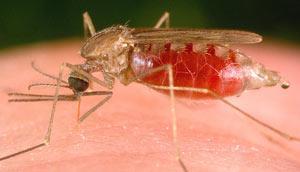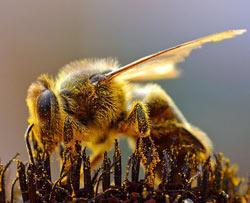The powerful sense of smell that insects possess is being put to use in applications from detecting rotten tomatoes to controlling one of the deadliest of diseases in Africa. John Bonner finds out more.
The powerful sense of smell that insects possess is being put to use in applications from detecting rotten tomatoes to controlling one of the deadliest of diseases in Africa. John Bonner finds out more.
Twilight on the Tanzanian plains and a Masai herdsman dozes by the fire as he keeps watch over his cattle, unaware that he is being stalked by Africa’s most lethal killer. Guided by its remarkable sense of smell, the creature edges closer to its prey. Without warning, it emerges from the darkness and launches itself at his unprotected neck .
.This is a story played out every day and one that usually ends with a slapping noise, as the beast - a malaria-carrying Anopheles gambiae mosquito - is crushed under the palm of its intended victim. Yet the tale has an enduring fascination for a team of chemists and biologists working thousands of miles away in Hertfordshire, UK.

They want to know how the insect can detect human odours in the vanishingly small concentrations wafting over its sensory antennae and how it is able to pick them out among the thick fug of near identical volatile compounds given off by the surrounding cattle.
Staff at the Rothamsted research centre have been investigating the insect olfactory system for decades. Early studies aimed at finding ways of controlling medical or agricultural pests manipulated the pheromones used by insects as sexual signals. That work has now branched off into two new areas: fundamental research into the mechanism of olfaction across the whole animal kingdom, and applied work using the exquisite sensitivity of insect sense organs as potential analytical tools. These could be used in a wide range of applications, such as quality control in the food industry, in disease diagnosis, and to identify contraband drugs and hidden explosives.
’Biological systems have sensitivities several orders of magnitude higher than the best artificial noses that we have developed. A gas chromatograph/mass spectrometer (GC-MS) will be able to detect compounds at the nanomolar or picomolar level but an organism may respond to some compounds found at femtomolar concentrations. It all depends on how important that compound is to the animal,’ explains John Pickett, head of the lab’s biological chemistry division.
Bio detection machines
Sniffer dogs employed by police and airport security departments are one existing example of the value of biological detection systems. But Pickett believes that insects have many advantages over mammals. ’They are much more like machines. A dog is like us, it may get hungry or bored and it loses interest. There may also be problems resulting from the emotional relationship between a dog and its handler. One area under investigation at the moment is in clearing land mines - a handler would be anxious about sending his dog into a minefield and the animal would pick up on that.’
Apart from obvious differences at the gross anatomical level, the olfactory systems of insects and vertebrates are strikingly similar. In insects, odours are detected on finger-like protuberances on the antenna, called olfactory sensilla.
The odorant molecule passes through pores in the outer cuticle of the sensillum and becomes attached to an odorant binding protein (OBP). This protein carries the hydrophobic ligand through the lymph fluid found inside the cell and attaches it to a receptor on the dendritic projections of a sensory nerve cell. The initial signal from this receptor to the central nervous system is amplified by the activation of the G protein pathway that is a common feature of signal transduction systems in all living organisms.
However, the position of the insect olfactory organs on the surface of its body allows them to be investigated using methods which would be ethically unacceptable in vertebrates.
A technique developed by German biologist Dietrich Schneider in the 1950s enables researchers to make direct recordings of activity in insect olfactory nerves and identify the specific plant or animal-derived compounds that trigger a behavioural response.
Sensing physiological responses
Using this method, a fine tungsten electrode is inserted into the antenna of an immobilised insect and manipulated until it picks up the spontaneous activity of a sensory neuron. A current of air containing the compounds under investigation is passed over the antenna and simultaneously through a gas chromatograph. The investigators then compare the activity in the nerve cells with peaks seen on the GC readout. They may also try to link the compound which produces the physiological activity to a particular behavioural response - for example, male moths fluttering their wings on encountering a female pheromone.
In theory, the GC reading of physiological and behavioural responses should coincide but in a complex biological system things are rarely that simple. ’There are many different compounds in the sample and usually the one we are interested in is there at such low concentrations that it barely registers on the GC trace,’ explains Lester Wadhams, head of the lab’s chemical ecology group. ’Often it is hidden by another compound of the same GC retention time present in much greater concentrations. And sometimes the behavioural response occurs at a point where there appears to be nothing there, because it happens through a synergistic interaction of two or more compounds.’
Rotting fruit
Nevertheless, the technique is reliable enough to detect early signs of degradation in food products, as shown by the results of a now completed project funded by the biotechnology and biological science research council (BBSRC).
The Rothamsted team was asked to find volatile markers appearing as evidence of deterioration in tomatoes and fish. For this, they used recordings from the antennae of ecologically relevant species that would be attracted to those products both to feed and lay their eggs - the fruit fly Drosophila melanogaster and the bluebottle Calliphora vomitoria.

They took air samples in a glass syringe from the air above punnets of cherry tomatoes that were showing visible signs of deterioration. Unlike samples from fresh fruit, these would elicit a strong electrophysiological response from the fruit fly antenna.
The next stage compared the differential response to air taken from two samples of tomatoes that both appeared to be in perfect condition. Left for four days, the fruit that had elicited intense electrical activity showed clear signs of deterioration while the other sample was still in good condition.
But as well as detecting incipient deterioration that is invisible to the human eye, the technique was also highly sensitive. Air samples taken from a punnet containing a single imperfect tomato would still provoke a response against the background odour of 23 healthy fruits.
Commercial food tests
After identifying the active peaks in the GC trace, the Rothamsted team used GC-MS to identify the specific compounds involved. The results are so far unpublished because laboratory staff are planning to develop a commercial test system in collaboration with a food company.
But if the project is successful, the same basic technology could probably be used to monitor a number of different food products. This is because of the limited range of insect olfaction - compared with mammals, insects recognise and respond to relatively few volatile compounds that are directly important to their biology.
In fruit flies, the key compounds are unsaturated aldehydes produced along the isoprenoid pathway, says Pickett. Meanwhile, in a completely unrelated project, similar indicators of oxidative stress were found to determine the extent to which parasitic flies were attracted to individual cattle in a herd.
However, an insect-based assay could be useful for detecting the presence of compounds that would have no conceivable ecological relevance to the insect concerned. Rothamsted staff have used the adaptable behaviour of that most sophisticated and useful of insect species - the honey bee Apis mellifera - in detecting anthropogenic compounds as diverse as cocaine and Semtex.
Sniffing out prizes
A convergence between electrophysiological studies and genomics has opened a door towards a better understanding of the olfactory process in insects and vertebrates.
In 2004, Richard Axel and Linda Buck, both from the US, won the Nobel prize for medicine for their work in identifying the genes coding for odour receptors in the nasal tissue. Their work has advanced knowledge of the function of the olfactory system in both groups. ’But we still don’t really know how its works - we haven’t worked out how the process of molecular recognition works or how that information is processed in the nervous system,’ Pickett observes.

Even the relatively olfactorily-challenged human species can recognise up to about 10,000 different odours. But each olfactory neuron only possesses a single receptor type and there are only an estimated 1000 receptor genes in the human genome. It is not known how these different receptors interact to cope with a wide repertoire of potential targets or whether receptor cells can change the particular molecule expressed.
Based on their studies of the much simpler insect model, the Rothamsted team suspects that the OBPs that ferry odour molecules across to the receptor play a key role in the process. Evidence suggests that they play some role in discrimination rather than being simple transporters. However, early studies on the function of these proteins have produced confusing results. Genes for these proteins have been cloned and the proteins expressed in bacteria. Once extracted the proteins were found to bind promiscuously with a large number of compounds - including many that don’t occur naturally or are irrelevant to the insect life cycle.
To clarify this situation, Pickett’s team has been awarded a grant as part of a major BBSRC programme on protein-ligand interactions. They will be trying to identify and explore the properties of OBPs in two species for which we have complete genome sequences - the fruit fly and the A. gambiae mosquito. In the latter case, they will be comparing the genes responsible for OBPs in this species and a close family member, A. arabiensis, which feeds on cattle in preference to humans. There are about 20 OBP genes in these two related species and the majority are common to both - so the rare differences probably hold the key to understanding host selection. The research could also point the way to developing new methods for controlling a disease that kills more than two million people, mostly children, every year.
Sensor on a chip
But nearer to home, a better understanding of the properties of OBPs could see them being used as the basis for a new generation of odorant sensors. OBPs are globular proteins of about 16 kDa and are robust enough to stand up to substantial mistreatment - even boiling - without denaturing and losing their binding properties.
Pickett suggests that this could make OBPs candidates for a simple ’sensor on a chip’, in which the conformational change that occurs when the protein binds to its ligand is detected by some form of simple optical process. ’There are various ways of taking this technology forward - either using the complete insect or using components of its olfactory system in combination with human devices. But the whole insect approach has one major advantage in that you don’t need to develop the amplification technology needed to produce a detectable signal - Nature has already done it for you.’
John Bonner is a freelance science writer based in London, UK.
Trainer bees
Honey bees forage on a wide variety of flowers and remember the smell of any new variety that they find to be a good source of nectar. This behavioural flexibility is being exploited by Inscentinel (formerly Insense), a company formed at Rothamsted to develop insect-based technology for detecting illicit or dangerous materials.
Bees from the company hive are placed inside a small compartment within a sensor module. There they can be trained to respond to an unfamiliar odour by simple Pavlovian conditioning - the smell is wafted over them at the same time as they receive a meal of sugary water. Eventually, they will extend their tongue-like proboscis in anticipation of a meal at the mere sniff of the target odour. Inscentinel’s general manager, Rachael Carson says the training phase only takes a few minutes and is successful in 95 per cent of cases - the rare failures are usually those bees that are too aggressive to be coaxed into the detector unit. Trained bees can be kept in the module for up to a week before being released back to the hive.

The company was originally established as a spin off from Unilever Research but is now jointly owned by the BBSRC and a venture capital company. Inscentinel has developed the sensor module, camera and associated software for analysing the bees’ behaviour and detecting proboscis extension responses. The next phase of the research will aim at developing an automated process for loading and training the bees to enable the sensor systems to be dispatched and used wherever they are needed.
The potential value of this system for military and security purposes persuaded the US government to fund most of the early phase research. But Carson believes the technology could be used much more widely. There are obvious applications for the technology in the food industry and preliminary work suggests that the bees can also detect some so far unidentified biochemical marker in the breath of tuberculosis patients. Inscentinel is therefore planning a research project with the London School of Hygiene & Tropical Medicine to validate the technique in human disease diagnosis.






No comments yet